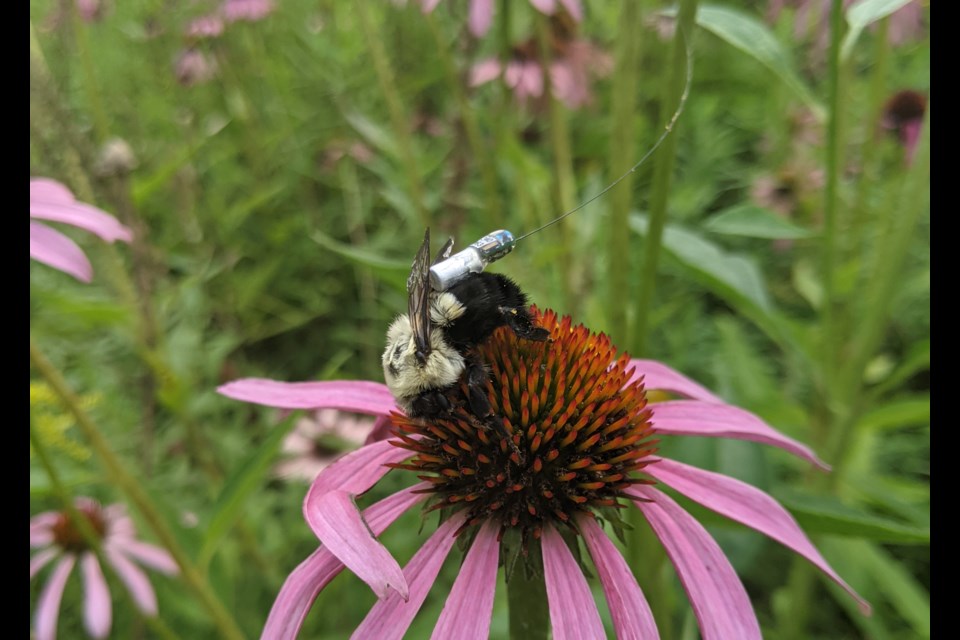Where do eastern queen bumble bees go in the winter? That’s what a University of Guelph study is trying to find out.
Amanda Liczner, a postdoctoral researcher at U of G, and her team are putting radio trackers on queen bumble bees to try and track where they go for the winter.
“We don't know a lot about queen bumble bee overwintering habitat because they overwinter underground whenever they're ready to go overwinter,” said Liczner.
“They go and find a spot and bury themselves in the ground so obviously it's very hard to find where they go, if they're underground,” said Liczner.
Liczner is working on this project with U of G professor Nigel Raine who studies pollinator conservation and behaviour in Ontario. The two conduct their studies at the rare Charitable Research Reserve in Cambridge.
Liczner studied bumble bee habitat conservation while completing her PhD and said an important part of habitat selection is measuring species movements to understand how they select different areas for habitat and how they move through the environment.
“With climate change being such a big impact on bumble bees, we need to know stuff like how they disperse, what kind of habitats they can move through which we don't really know a lot about," said Liczner.
She said studying bee movement will help understand if they will be able to shift their distribution with ongoing climate change.
“It's just really cool to me to study species movement and their behavior and how they make the different decisions in their day to day lives and as a species,” said Liczner.
“It's just so amazing.
“They're very cute, they're very big, they're pretty easy to identify and they're just kind of funny to watch.”
The team uses super glue to attach a tracker that weighs 0.13 grams onto the queen bee’s back. Because cold temperatures slow a bee down, bees are first placed down in a cooler so they stay still.
“Bees can carry up to 30 per cent of their body weight in nectar or pollen when they're just collecting it. So the trackers are below that,” said Liczner, adding that in the future the team will test the impact of trackers on the bees' flight as well.
The tracker comparable to the width of a violin string is one cm long and has an antenna that picks up at the back and measures 10 cm.
“But we trim it to around five just so they're not getting tangled in like the flowers and the vegetation. That's not very fun,” Liczner.
“So we spread their wings out of the way, put some glue on the abdomen, and then we stick the tracker on there, hold it in place for a few minutes while it dries,” said Liczner.
The second part of the project is looking at how pesticides impact queen bumble bee movement
Liczner said the team tested a pesticide called neonicotinoids which is known to have negative impacts on bee flight and memory. The other class of pesticides it is studying is called Diamides, a new pesticide with little research in relation to bees.
Liczner said the team predicts that diamides might become more prominent while neonicotinoids get more regulated.
“There's more evidence that they're bad, not only for bees or for other species, and the diamides don't have a lot of research on them right now to see what kind of impacts they might have on pollinator movement,” said Liczner.
“We think they might have impacts on upon their movement because their mode of action is by through the muscles so it paralyzes the insect so it's gonna impact muscles and slice important muscles that we think might impact their flight, but it might not, it has a lower toxicity than neonicotinoids, so we're kind of, we're comparing the new class the new next to see if they're less harmful, just as harmful more harmful.”
The pesticide treated bees are from commercially purchased colonies and the wild bees are scouted for in the wild and released back where into the location they were originally found.
Liczner said the study is currently wrapping up in a couple of weeks. “It’s getting cooler so the bees are much less active. We're not seeing quite as many,” she said.
She said the team will try to complete another study in the springtime to study bee movements in the spring.



